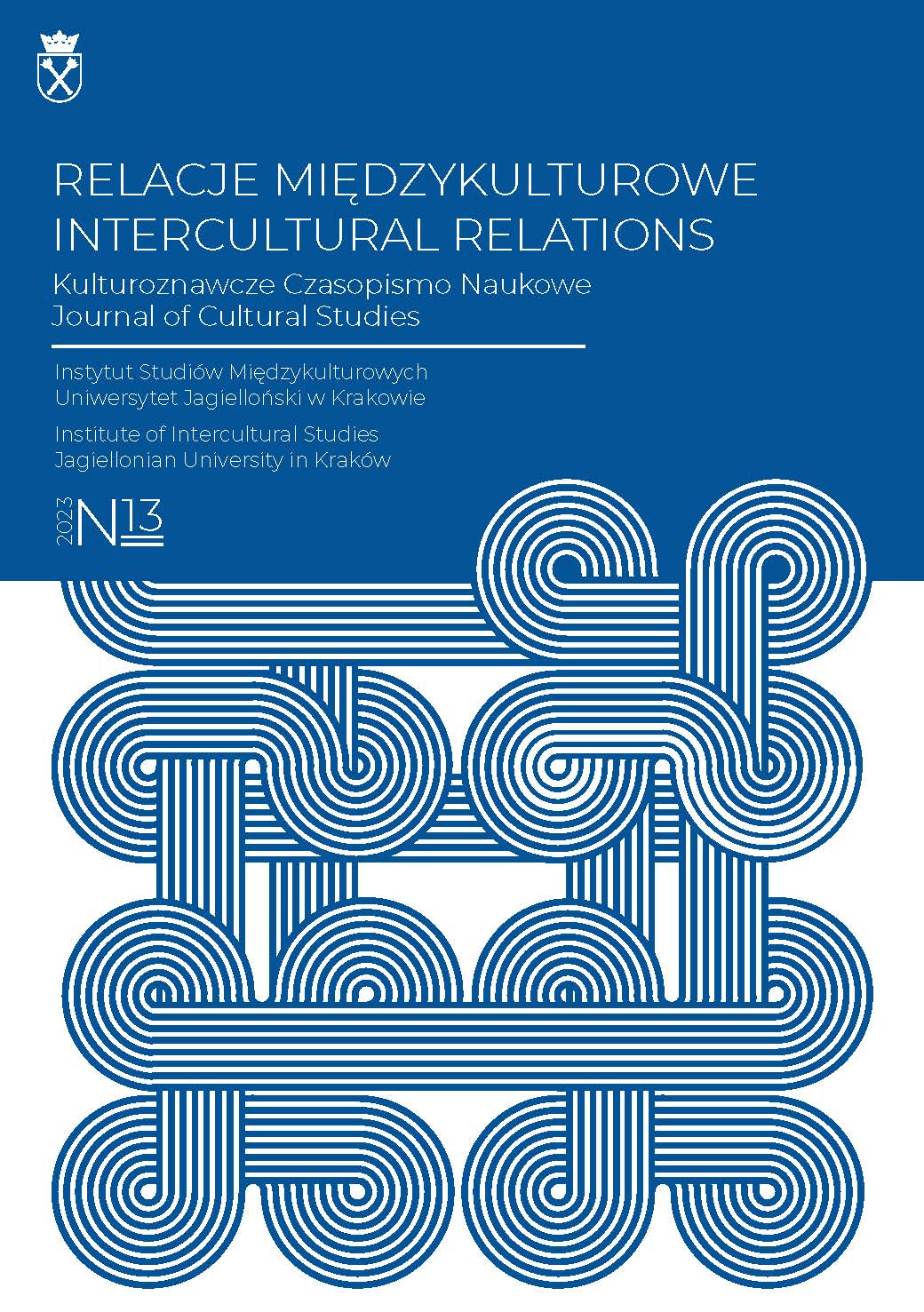Powojenny japoński pacyfizm jako narzędzie budowania dialogu międzykulturowego
DOI:
https://doi.org/10.12797/RM.01.2023.13.03Keywords:
pacifism, Japan, intercultural dialogueAbstract
POST-WAR JAPANESE PACIFISM AS A TOOL FOR BUILDING INTERCULTURAL DIALOGUE
The end of World War II marked the beginning of a long and complicated process of reconstructing a collective identity for the Japanese people, a process that largely continues to this day. The best example of this is the presence of contrasting attitudes toward the events of the war. This article highlights issues related to pacifist values and their relevance to the collective identity of contemporary Japanese. With the collapse of the previous identity at the end of World War II, pacifism has become one of the key values for contemporary Japanese. Using the concept of “core values” developed by Jerzy Smolicz, this article examines postwar pacifist movements from the mid-1950s through the 21st century.
References
Ambasada Japonii w Polsce. 2012. Konstytucja Japonii z 3 listopada 1946 (przeł. Teruji Suzuki), http://www.pl.emb-japan.go.jp/relations/konstytucja.htm – 25 V 2022.
Ando, T. 2014. Japan’s New Left Movements: Legacies for Civil Society, Oxon.
Asahi Shimbun. 2014. Shūdanteki jieiken kōshi yōnin hantai 63% ni zō, Asahi Shinbun chōsa, http://www.asahi.com/articles/ASG3L72L6G3LUZPS007.html – 20 V 2022.
Asahi Shimbun. 2015. Kenpō kaisei fuyō 48%, hitsuyō 43% Asahi shinbunsha senron chōsa, http://www.asahi.com/articles/ASH4H4KBCH4HUZPS003.html – 21 V 2022.
Asahi Shimbun. 2018. Abe seikenka no kaiken [hantai] 58% Asahi senron chōsa, https://www.asahi.com/articles/photo/AS20180501004202.html – 18 V 2022.
Barthes, R. 1967. Elements of Semiology, London.
Bix, H. P. 1996. Japan’s Delayed Surrender: A Reinterpretation. W: M. J. Hogan (red.), Hiroshima in History and Memory, Cambridge, 80–115.
Breen, J., Teeuwen, M. 2010. A New History of Shinto, Oxford, https://doi.org/10.1002/9781444317190.
Cai, Y. 2008. The Rise and Decline of Japanese Pacifism, New Voices, 2, 179–200, https://doi.org/10.21159/nv.02.09.
Dower, J. W. 1996. The Bombed: Hiroshimas and Nagasakis in Japanese Memory. W: M. J. Hogan (red.), Hiroshima in History and Memory, Cambridge, 116–141.
Futamura, M. 2007. War Crimes Tribunals and Transitional Justice: The Tokyo Trail and the Nuremberg Legacy, New York.
Gustafsson, K., Hagström, L., Hanssen, U. 2019. Long Live Pacifism! Narrative Power and Japan’s Pacifist Model, Cambridge Review of International Affairs, 32(4), 502–520, https://doi.org/10.1080/09557571.2019.1623174.
Hajimu, M. 2012. Fear of World War III: Social Politics of Japan’s Rearmament and Peace Move, Journal of Contemporary History, 47, 551–571, https://doi.org/10.1177/0022009412441650.
Hobsbawm, E. 2008. Wprowadzenie. Wynajdywanie tradycji. W: E. Hobsbawm, T. Ranger (red.), Tradycja wynaleziona, Kraków, 9–23.
Hook, G. D., Gilson, J., Hughes, Ch. W. et al. 2005. Japan’ International Relations: Politics, Economics and Security, Oxon.
Iida, Y. 2002. Rethinking Identity in Modern Japan: Nationalism as Aesthetics, London.
Jansen, M. B. 2002. The Making of Modern Japan, Cambridge.
Japanese Ministry of Education, Culture, Sports, Science and Technology. Chūgakkō gakushū shidōyōryō (heisei 29 nen kokuji) kaisetsu, http://www.mext.go.jp/component/a_menu/education/micro_detail/__icsFiles/afieldfile/2018/05/07/1387018_3_1.pdf – 05 XII 2021.
Kłoskowska, A. 2005. Kultury narodowe u korzeni, Warszawa.
Korporowicz, L. 2018. Jagiellońskie Studia Kulturowe jako projekt kulturoznawczy, Relacje Międzykulturowe – Intercultural Relations, 1(3), 103–127, https://doi.org/10.12797/RM.02.2018.03.08.
Mainichi Simbun. 2015. Honsha senronchōsa: 9 jō kaisei hantai 55%...sakunen yori zō, http://mainichi.jp/select/news/20150504k0000m010056000c.html – 20 XI 2021.
Ministry of Foreign Affairs of Japan. On the Occasion of the 50th Anniversary of the War’s End, http://www.mofa.go.jp/announce/press/pm/murayama/9508.html – 3 XII 2021.
Ministry of Foreign Affairs of Japan. Three Non-Nuclear Principles, https://www.mofa.go.jp/policy/un/disarmament/nnp/index.html – 4 IV 2023.
New York Times. 2012. Tokyo Rally Is Biggest Yet to Oppose Nuclear Plan, https://www.nytimes.com/2012/07/17/world/asia/thousands-gather-in-tokyo-to-protest-nuclear-restart.html – 7 VIII 2021.
New York Times. 2015. Abe Is Said to Have Plans to Revise Pacifist Charter, https://www.nytimes.com/2015/02/06/world/asia/abe-wants-to-revise-pacifist-constitution-as-early-as2016-ally-says.html – 2 I 2022.
NHK News Web. Kenpō ni kan suru ishiki chōsa 2018, https://www3.nhk.or.jp/news/special/kenpou70/yoron2018.html – 25 V 2022.
NHK News Web. Senron chōsa: Nihonjin to kenpō 2017, https://www3.nhk.or.jp/news/special/kenpou70/yoron2017.html – 25 XI 2021.
Olick, J. K., Levy, D. 1997. Collective Memory and Cultural Constrain: Holocaust Myth and Rationality in German Politics, American Sociology Review, 62, 921–936, https://doi.org/10.2307/2657347.
Olick, J. K. 1998. Introduction: Memory and the Nation: Continuities, Conflicts, and Transformation, Social Science History, 22, 377–387, https://doi.org/10.2307/1171569.
Orr, J. J. 2001. The Victim as Hero. Ideologies of Peace and National Identity in Postwar Japan, Honolulu.
Paine, S. C. M. 2003. When Japan Become World Power: the Sino-Japanese War of 1894–1895, Cambridge.
Pletnia, M. 2019. Pamięć zbiorowa o wojnie na Pacyfiku w powojennej Japonii, Kraków.
Reuters. 2015. Huge Protest in Tokyo Rails against PM Abe’s Security Bills, https://www.reuters.com/article/us-japan-politics-protest/huge-protest-in-tokyo-rails-against-pm-abessecurity-bills-idUSKCN0QZ0C320150830 – 26 XI 2021.
Downloads
Published
Issue
Section
License

This work is licensed under a Creative Commons Attribution-NonCommercial-NoDerivatives 4.0 International License.






